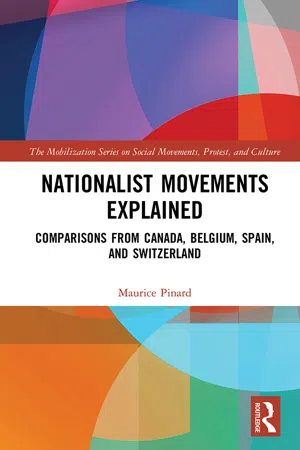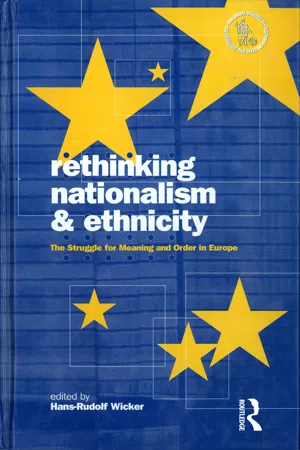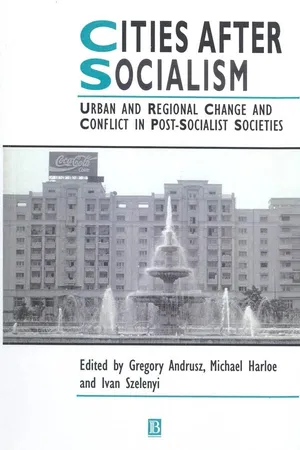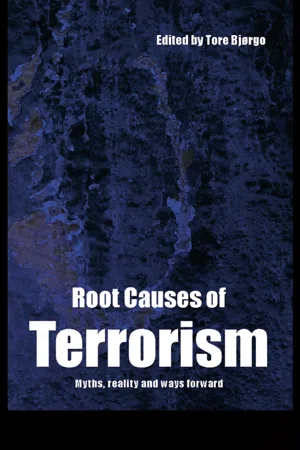Ethnic Nationalist Movement
The ethnic nationalist movement refers to a political and social movement driven by the desire to establish or maintain a separate identity and political autonomy for a specific ethnic group. It often involves the promotion of cultural, linguistic, and historical distinctiveness, and can lead to demands for self-determination or independence. This movement is shaped by the unique geographical and historical context of the ethnic group.
8 Key excerpts on "Ethnic Nationalist Movement"
- eBook - ePub
Nationalist Movements Explained
Comparisons from Canada, Belgium, Spain, and Switzerland
- Maurice Pinard(Author)
- 2020(Publication Date)
- Routledge(Publisher)
...Conversely, in the present study the central analytical preoccupations are to explain nationalist contention, that is, what are first and foremost the causes, the determinants, which lead to the emergence and development of the national question, namely constitutional goals of greater autonomy or complete secession, both subsequently adopted by nationalist movements and parties. More generally, the theoretical differences between these studies reflect, in our study, the vast literature on social movements and contentious collective action among sociologists and, in the second study, the vast literature on electoral politics among political scientists. Notes 1 The term nationalist movements or parties, currently frequent in the literature, will be employed, but other terms, as synonyms, could be ethnoregionalist, ethnonationalist, or ethnopolitical movements and parties; the latter term has the advantage of stressing the politicized nature of these movements, and their involvement in various forms of contentious political action. The ethno component of the terms is a generic reference to ethnic, but also racial, linguistic, or even religious groups. For a discussion of these points, see Gurr (1993a). 2 Communal groups refer to communities whose members identify with one another on the basis of common traits, such as ethnic, racial, linguistic, religious, or regional characteristics (Gurr 1993a)....
- eBook - ePub
Rethinking Nationalism and Ethnicity
The Struggle for Meaning and Order in Europe
- Hans-Rudolf Wicker(Author)
- 2020(Publication Date)
- Routledge(Publisher)
...It is essential for this discussion, however, to clarify a contrasting theoretical trait common to studies of nationalism, this being the establishment of a dividing line between ethno-nationalism and ethnic revivalism. Ethno-nationalism is understood here to mean politicized demands of stateless ethnic groups via negotiation or coercion (e.g. political parties or armed movements) seeking to achieve sovereignty and self-rule. Ethnic revivalisms, on the other hand, are organized demands of ethnic peoples pressing for cultural and linguistic recognition within the administrative and territorial boundaries of a nation-state. Leaders or intellectuals of ethnic revivalisms, through organized campaigns, cultural groups, public meetings and publications, seek to obtain adequate official treatment concerning the special needs of complex ethnic ways of life, by demanding the implementation of effective bureaucratic action (e.g. multiculturalist policies and tolerance to ethnic diversity). While ethno-nationalisms theoretically represent a threat to the national state, ethnic revivalisms do not pose an end to the nation-state. Rather, they exhaust the nation-building project based on the assimilation or exclusion of ethnicity. The access of marginal ethnic peoples to the modernity of the nation-state will be explored through a comparison of two leading methodologies of nationalism which emerged in the 1980s: the ‘modernist’ school, particularly the model delineated by Ernest Gellner (1926–1995) and a second school, which I call the ‘historical-culturalist’ approach associated with the work of Anthony D. Smith (born 1933). 1 I propose that it is possible to use these models in a complementary fashion, despite their antagonistic conceptualizations...
- eBook - ePub
Language and Minority Rights
Ethnicity, Nationalism and the Politics of Language
- Stephen May(Author)
- 2013(Publication Date)
- Routledge(Publisher)
...In the European Union, for example, the increasing move toward regional autonomy, particularly via the notion of ‘Europeanization’, has strengthened rather than weakened the tenets of some cultural nationalist movements there (D. Smith and S. Wright, 1999; Keating, 2009; Fitjar, 2010). Certainly, this is the case in both Wales and Catalonia, as will be evident in Chapter 7. It is also the case, in a different political arena, for indigenous peoples’ movements. In recent years, Sámi (Lapps) in Norway, Inuit (Eskimos) and Native Canadians in Canada, Māori in Aotearoa/New Zealand and, to a lesser extent, Aboriginal peoples and Torres Strait Islanders in Australia, have all been granted varying degrees of cultural, linguistic, educational and administrative autonomy, albeit in the face of at times considerable opposition. As I will discuss further in due course, these developments have been the direct result of indigenous advocacy, in national and international arenas, for greater autonomy within the nation-states that colonized them, rather than for secession as such (May, 1999c, d, 2002; see also Chapter 8). The modernist mistake then has been to assume that cultural and political nationalisms are entirely separate phenomena – the former related only to ‘ethnic’ groups, the latter only to ‘national’ ones – rather than distinct variants of the same phenomenon. This dominance of statist or political forms of nationalism, and the consigning of cultural nationalism to the realms of ‘mere ethnicity’, can be traced back to the principle of nation-state congruence discussed in the preceding section. Nationalism is only nationalism (and therefore justifiable), it seems, when it is tied to the modernizing state (Calhoun, 1993a). This is to miss an essential element of the power of nationalism, its protean or chameleon-like quality (Anthony Smith, 1995a; Brubaker, 1998)...
- eBook - ePub
- Anthony Smith(Author)
- 2013(Publication Date)
- Polity(Publisher)
...But there were earlier ideologies and movements which prefigured nationalism. These are ethnicist movements in defence of given ethnies, both lateral and vertical, and an ethnocentrism whose basis is a missionary sense of ethnic chosenness. Sometimes such movements flared up into open revolt and warfare, as when the Ionians and Egyptians revolted against the Achaemenid Persians, the Gauls and Jews against the Romans, and the Swiss and Scots against the Habsburgs and Plantagenets. These ideals and the heroic legends that grew up around these exploits have undoubtedly influenced the modern nationalist aspirations of particular ethnies ; and a later, secular nationalism has modified but retained some of the older heroic traditions and myths of ethnic election. 17 ‘Core’ and ‘periphery’ A second important ethnic legacy from pre-modern epochs has been the survival of many so-called ‘peripheral’ ethnies. These are usually demotic or ‘vertical’ in character. Examples from the West would include the Quebecois, Basques, Catalans, Corsicans, Bretons, Welsh, Scots, Frisians, to name just a few; outside Europe, there are the Ewe, Bakongo, Copts, Kurds, Druse, Sikhs, Nagas, Tamils, Moro and Australian Aborigines. These ethnic communities have in the past stood (and in some cases still stand) in relations of alienation and subordination to larger, dominant ethnies whose elites ruled the state into which they had centuries ago been incorporated by expansionist lords and monarchs, or more recently by European colonial powers. The leaders of these peripheral ethnies, or the leaders of movements claiming to speak on their behalf, frequently contend that their communities continue to be exploited and oppressed in varying degrees. In the past, social, cultural and political issues formed the basis of protest...
- eBook - ePub
- Stefan Berger, Eric Storm, Stefan Berger, Eric Storm(Authors)
- 2019(Publication Date)
- Bloomsbury Academic(Publisher)
...11 The spatial turn and the history of nationalism: Nationalism between regionalism and transnational approaches Eric Storm Introduction Most historians today agree that nations are constructed and their borders largely arbitrary. So, why should we study nationalism by limiting ourselves to the boundaries of existing nation states or nationalist movements? In fact, since the 1990s historians have been analysing the interaction between local, regional and national identities, mostly by concentrating on the territorial identification processes in a specific city or region. Other scholars examined transborder influences on the nation-building process by focusing on the role of emigrants, borders, transfers or the impact of foreign scholars and tourists. As a consequence, nationalism is now being studied at various geographical levels besides the traditional emphasis on the nation itself: the local, the regional, the transnational and the global (which will be the topic of C hapter 12). This chapter aims to provide an overview of the impact of the ‘spatial turn’ on the history of nationalism. Globalization and the spatial turn The spatial turn in the humanities and social sciences can be understood as a reaction to the globalization that rapidly gained momentum after 1989. During the Cold War, the division of the world in the capitalist West, the communist East ern Bloc and the Third World was taken for granted and there seemed to be no signs of imminent change. The basic units of the three blocks were independent nation state s. Ethnic strife and secessionist movements still existed, but apart from a few unsatisfied regions in the West – such as Quebec or the Basque Country – this was largely limited to the new nation states in Africa and Asia. This stable worldview was shattered by the fall of the Berlin Wall in 1989. It seemed as if the lid of the pressure cooker had been removed as ethnic rivalries boiled over in various parts of the world...
- eBook - ePub
Cities After Socialism
Urban and Regional Change and Conflict in Post-Socialist Societies
- Gregory Andrusz, Michael Harloe, Ivan Szelenyi, Gregory Andrusz, Michael Harloe, Ivan Szelenyi(Authors)
- 2011(Publication Date)
- Wiley-Blackwell(Publisher)
...Thus, in this view those who actively mobilize are not to be seen as undeveloped ‘hillbillies’, incapable of modernizing and nation-building. Members of the dominant nation have penetrated the life sphere of the sub-nation (as did the Italians in South Tyrol), and its (regional) economy has been made into an appendix of the national economy. The economic life-chances of classes and ethnic groups are distorted, making conflicts seemingly inevitable. Reactive nationalism develops most frequently in areas where the economy is in decline. In some cases, such as in Belgium, the two major ethnic groups compete in nationalistic terms, Wallonia was once the industrial centre but later declined to a ‘black country’. The Flemish-speaking parts, on the other hand, developed from being agrarian-based into the loci of modern industries. Then in the 1980s the former dominant group, the Walloons, began to feel like a suppressed minority. Nevertheless, the now dominant ethnic group, the Flemings, retained their militant, nationalist attitude since they felt culturally inferior. It is possible that the Ukraine might develop along this path. Reactive nationalism can be linked to a model of ethnic competition. Modernization does not extinguish feelings of national identity. On the contrary, it is only when modernization has succeeded in overcoming family and parochial loyalties that sub-nations are able to begin discovering their identity. Ethnic mobilization is more important than is suggested by deterministic, evolutionary theories of the modernization process, which assume that history takes its inevitable course. Mobilization occurs when the pressure of the forces of modernization give rise to competition between identifiable ethnic units for jobs, housing and other benefits. For political scientists who have an interest in actors and not only in autopoietic processes of self-development, a resource approach to nationalism can be most fruitful...
- eBook - ePub
Root Causes of Terrorism
Myths, Reality and Ways Forward
- Tore Bjørgo(Author)
- 2005(Publication Date)
- Routledge(Publisher)
...Accordingly, they are particularly congruent with the foundations of open and pluralistic polities, though not necessarily bound to be peaceful. Constitutional patriotism, for instance, would correspond to what is conceptualized as civic nationalism. However, nationalist doctrines resembling the ethnic version usually adopt an exclusionary character and would therefore be prone to violent confrontation with the excluded aggregate inside or outside a given country. Whereas civic nationalism would emphasize the protection of individual rights and public liberties, ethnic nationalism concedes priority to the claims of presumed aggregate demands, to the point of justifying or tolerating human rights violations insofar as these shared aspirations are advanced. Ethnic nationalism resembles in this sense the somewhat earlier and more classical notion of integral nationalism, opposed during the nineteenth century to that of liberal nationalism, to the extent that the former was thought of as linked to a closed society in which the individual counted for less than the national collectivity (Hayes 1931). Surely not by accident, most of the contemporary terrorist organizations espousing independentist or irredentist goals have been inspired by ethnic nationalisms turned into ideologies of violence. Ethnic nationalism has provided exclusionary attitudes and dichotomic beliefs to those who engaged in the most deadly and enduring separatist terrorist campaigns since the late 1960s, largely carried out in the context of democratic regimes. The trajectories of the IRA and ETA in relation to original Irish and Basque nationalism respectively, or even that of the FLNC with respect to Corsican nationalism, illustrate this assertion. Ethnic nationalism, coupled with secular doctrines or religious creeds, also underlines the most relevant cases of independentist and irredentist terrorist campaigns conducted in semiperipheral regions of the world, as mentioned earlier...
- eBook - ePub
Territories
The Claiming of Space
- David Storey(Author)
- 2012(Publication Date)
- Routledge(Publisher)
...In a variety of ways, territorial strategies are used not just as a means of exerting control over space, but to attain broader political goals. These contested spaces also reflect ideas of imagined communities and, of course, tell us something about imagined differences. While conflicts generally have a material base (connected with oppression or discrimination), ethnic differences tend to be emphasized and made ‘real’ so that each side creates and reproduces sets of assumptions about an essentialized ‘other’. Note 1 Lyrics available at www.lyricstime.com Further Reading The works listed below deal with the importance of landscape imagery and its links to wider notions of nationhood, the links between place and national identity, and the emergence of national traditions in a number of different countries. Some material directly concerned with the examples used in the chapter is also included. Boyce, D. G. (1982) Nationalism in Ireland, London: Croom Helm. Bunce, M. (1994) The Countryside Ideal. Anglo–American Images of Landscape, London: Routledge. Cosgrove, D. and Daniels, S. (eds) (1988) The Iconography of Landscape, Cambridge: Cambridge University Press. Dahlman, C. (with T. Williams) (2010) ‘Ethnic enclavization and state formation in Kosovo’, Geopolitics 15(2): 406–430. Daniels, S. (1993) Fields of Vision. Landscape Imagery and National Identity in England and the United States, Cambridge: Polity Press. Gagnon, V. P. (2006) The Myth of Ethnic War: Serbia and Croatia in the 1990s, Ithaca: Cornell University Press. Glenny, M. (1996) The Fall of Yugoslavia. The Third Balkan War, 3rd edn, Harmondsworth: Penguin. Graham, B. (ed) (1997) In Search of Ireland. A Cultural Geography, London: Routledge. Graham, B. and Howard, P. (eds) (2008) The Ashgate Research Companion to Heritage and Identity, Aldershot: Ashgate. Graham, B., Ashworth, G. and Tunbridge, J. (2000) A Geography of Heritage. Power, Culture and Economy, London: Arnold. Hobsbawm, E...







